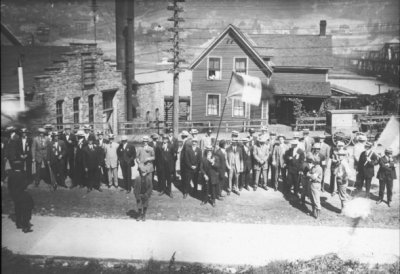According to the Alumnus of January 1912, the first alumni association was organized in 1892, with a membership of ten, and Samuel A. Parnall, class of 1888, was its first president. The members held meetings, elected officers, and held banquets welcoming the new graduates each year in the 1890s. By 1899, however, interest declined and meetings were not held regularly for the next several years.
A revival of the association took place at the famed 25th anniversary and the first alumni reunion in 1911. At that time, the members revised the constitution and made it possible for all alumni to become members by paying dues. A board of managers was selected while S. A. Parnall and J. L. Harris, both of the first graduating class, were granted life memberships. Dr. Wadsworth, former university president, was made the first honorary member of the revived Alumni Association. Following the reunion, a subsidized publication appeared on an erratic basis to record activities, not only on campus, but among the alumni.

Clubs were organized in various communities as graduates of the school located there. By 1912, about 1,584 students had attended the college; 636 had graduated, but only 286 had joined the association. The alumni expressed an interest in repeating these reunions every five years. The chairman of the Board of Trustees, Mr. Kelly, had proposed at the time of the 1911 reunion that another one be held, as indeed it was, in 1916.
After it was established in 1921, the Lode became a source of information – a point of contact – for former students as well as the students on campus. Its columns carried news about alumni that the Alumni Association's publications were not able to report. The college helped with funds when possible, but eventually, this became very difficult. Therefore, the board of managers again assumed complete responsibility for a publication to be sent to the alumni. Donald Gillies became president of the association in 1921 and held that office for ten years.
The association was a small, closely-knit group and students were able to read accounts of the success achieved in the field by graduates of the institution.
In the 1920s, the school was old enough to begin to acquire legacies. During the alumni reunion of 1926, the August 12 issue of the Lode listed 18 fathers and 23 sons who had attended the school. Specific mention was made of the combination of the Seamans and that a son-in-law and three nephews were in attendance. Mr. Uren of the class of 1888 and two sons in the class of 1923 were mentioned. In 1926, there had been five Botsfords and six Manderfields at Tech.
Founded in 1892 with very few members, the Alumni Association has grown over the years and became self-supporting – its executive secretary and staff paid by the Alumni Fund – and to provide the alumni with many services. James Fisher, veteran member and first dean of the faculty, was the link between the college and the alumni through most of his active career at Tech. He was the first more permanent alumni secretary. When he retired, Thomas Hruby '49 was selected to succeed him. Hruby, executive secretary, who retired in October 1985, expanded the association's membership and services to include a 21-member board of managers; three publications, Tech Outlook (published five times a year), and the Alumni Directory (once every five years); annual reunions each August; Distinguished Alumni and Outstanding Young Alumni Awards; and travel services. In addition, the association participated in fund-raising, searches for presidents of Tech, and recommending changes to the Board of Trustees.
Hruby was succeeded by Dean Woodbeck '78. In Fall of 1989, the position of Alumni Engagement director was split into two roles, Alumni and advancement communications being by retained by Woodbeck and the programming for the Alumni Association assumed by a new Alumni Relation Director Rick Yeo '66.
When Yeo was appointed the Athletic Director in 1990 and the position of Alumni Engagement director was assumed by Darcy Way '82 who had been a Tech Hockey Husky goalie from 1978 to 1982.
In 1997 the Alumni Association and the Alumni Engagement office relocated from the Alumni House which had been its home for many years, to the newly constructed Harold Meese Center. Sharing space with the university's career services office, the building also housed the Michigan Tech Student Foundation.
In November, 1998, Stephan Olsson '90, a native of Houghton, was named the University's fifth executive director of alumni engagement. Olsson succeeded Darcy Way, who became an advancement officer for the Athletic Department.
Alumni Association Board of Directors voted at their August 2002 meeting to abandon its membership program and invite all alumni to be a part of the association without fees. Funding for the alumni programs and services was provided by a combination of investment income from an endowed fund, royalty fees from corporate affinity program partnerships. The Alumni Engagement staff and office were supported through the university general fund.
Olsson resigned in 2006 and Ron Helman, retired Vice President of Advancement, acted as interim director until March 2007, when Brenda Rudiger was appointed Director of Alumni Engagement and Executive Director of the Alumni Association.
In the summer of 2010 the Alumni Association undertook major renovations to the Alumni House to establish a welcoming space for alumni visitors. The Alumni Engagement staff offices and the Michigan Tech Student Foundation made the Alumni House their home in September 2010.
A new MTUAA mission statement "Celebrating Traditions. Creating Connections." and Constitution were adopted in 2010 with the latter included provisions for the addition of a faculty representative on the Board of Directors. Dr. Jean-Celeste M. Kampe '80, '87 was appointed by Provost Max Seel to this newly created position.
Excerpted from Michigan Tech's 125 years of History and updated August 2012